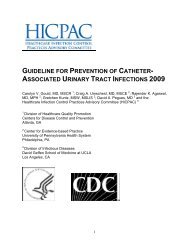SECT2.05 - Recommended Practices for Electrosurgery - Medline
SECT2.05 - Recommended Practices for Electrosurgery - Medline
SECT2.05 - Recommended Practices for Electrosurgery - Medline
- No tags were found...
You also want an ePaper? Increase the reach of your titles
YUMPU automatically turns print PDFs into web optimized ePapers that Google loves.
RP: <strong>Electrosurgery</strong>V.j.1.V.j.2.V.k.V.l.If any tension is applied to the dispersiveelectrode cord, the perioperativeregistered nurse should reassess theintegrity of the dispersive electrode, itscontact with the patient’s skin, and theconnection to the ESU.If the patient is repositioned, the perioperativeregistered nurse should verifythat the dispersive electrode is in fullcontact with the patient’s skin.Inadequate contact of the dispersiveelectrode may result in a burn. 65-67The single-use dispersive electrode shouldbe placed away from a warming device. 65,67The heat of a warming device may becumulative with the heating of the dispersiveelectrode and may affect how the dispersiveelectrode adheres to the skin. 65,67Dispersive electrodes should be kept dryand protected from fluids seeping or poolingunder the electrode. 23Liquids may prevent the electrode fromadequately contacting the skin. These solutionsalso can cause skin injury and burnsfrom prolonged skin exposure and concentrationof electrical current. 57V.m. Contact between the patient and metaldevices should be avoided. 69,70Metal devices (eg, OR beds, stirrups,positioning devices, safety strap buckles)could offer a potential alternate return path<strong>for</strong> the electrical current. 69,70V.m.1.V.m.2.Patient’s metal jewelry that is betweenthe active and dispersive electrodeshould be removed.Metallic jewelry, including body piercings,presents a potential risk of burnfrom directed current (ie, active electrodecontact); heat conducted be<strong>for</strong>e an electrodecools; and leakage current. Eliminatingmetal near the activation site minimizesthis risk. Jewelry that is left inplace, particularly on the hands, has thepotential to cause swelling at the site duringsurgery or recovery. 15Patient monitoring electrodes (eg, electrocardiogram,oximetry, fetal) shouldbe placed as far away from the surgicalsite as possible. 21V.m.3.V.m.4.V.n.V.n.1.V.n.2.V.o.Alternate pathway burns have beenreported at electrocardiogram (ECG)electrode sites and temperature probeentry sites with ground-referenced electrosurgeryunits. 19Needle electrodes <strong>for</strong> monitoring or nonsurgicalfunctions should be avoided. 18,21Stray current may flow through thesmall contact area of the needle electrodecausing a potential alternate pathwayand risk of patient burn. 18,21,71,72When use of needle monitoring electrodesis medically necessary, alternateelectrosurgery technologies (eg, bipolar,laser) should be considered. 18,73When multiple ESUs are used simultaneouslyduring a surgical procedure, the compatibilityof equipment and proper functioning ofcorresponding electrode monitoring systemsshould be verified with the manufacturer.Separate single-use dispersive electrodesshould be used <strong>for</strong> each ESU.The dispersive electrodes should beplaced as close as possible to theirrespective surgical sites and the single-usedispersive electrodes should not overlap.During high-current, long-activation-time,radio-frequency (RF) ablations and otherelectrosurgical procedures (eg, tumor ablation,bulk tissue resection), considerationsshould include, but not be limited to– identifying surgical procedures that requirethe use of high-current, long-activationtimeRF ablation and electrosurgicaltechniques;– taking inventory of RF generators thatrequire special or multiple dispersiveelectrodes;– following the manufacturer’s recommendations<strong>for</strong> use of large-size dispersive electrodesor multiple dispersive electrodes;– ensuring proper placement and full patientcontact of the dispersive electrode;– reviewing the manufacturer’s directions<strong>for</strong> use and requirements <strong>for</strong> accessories;– using and selecting the appropriate nonconductive,near-isotonic solution (eg,sorbitol, mannitol, dextran 10 or 70,106Equipment and Product Safety2012 Perioperative Standards and <strong>Recommended</strong> <strong>Practices</strong>
















